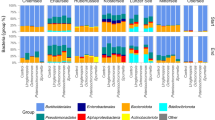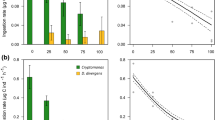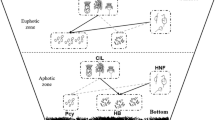Abstract
Mixotrophy by planktonic algae can dominate picoplankton predation in oligotrophic environments. We compared the grazing activity and prey preference of different mixotrophic taxa from natural communities of two oligotrophic shallow lakes (Escondido and Morenito) by performing eight laboratory grazing experiments using three different fluorescent prey (bacteria, picocyanobacteria, and picoeukaryotic algae). Eight taxa of mixotrophic flagellates (MF) corresponding to five different Classes, and two size categories of heterotrophic flagellates were distinguished. Chesson index showed that the ten identified protists preferred picocyanobacteria than bacteria, while picoeukaryotic algae were not ingested by any flagellate. In both lakes, MFs were responsible for ca. 80% of the picoplankton ingestion due to flagellates, and more than 50% of the total grazing impact when considering all flagellates, ciliates, and rotifers. Pseudopedinella spp. (Dictyochophyceae), Chrysochromulina parva (Haptophyceae), and Dinobryon divergens (Chrysophyceae) were the most important predators, while Plagioselmis lacustris (Cryptophyceae) and Chrysophyceae > 5 µm showed the lowest grazing rates. Overall, our findings support the idea of MF being the main picoplankton predators in oligotrophic systems. Besides, we also conclude that herbivory represents a key process in the mixotrophic carbon cycling in oligotrophic environments.





Similar content being viewed by others
References
APHA, 2005. Standard Methods for the Examination of Water and Wastewater. American Public Health Association, AWWA, Washington, DC.
Alonso, C., V. Rocco, J. P. Barriga, M. Á. Battini & H. Zagarese, 2004. Surface avoidance by freshwater zooplankton: field evidence on the role of ultraviolet radiation. Limnology and Oceanography 49: 225–232.
Ballen-Segura, M., M. Felip & J. Catalan, 2017. Some mixotrophic flagellate species selectively graze on Archaea. Applied and Environmental Microbiology 83: e02317.
Bastidas Navarro, M., B. Modenutti, C. Callieri, R. Bertoni & E. Balseiro, 2009. Balance between primary and bacterial production in North Patagonian shallow lakes. Aquatic Ecology 43: 867–878.
Bertilsson, S., O. Berglund, D. M. Karl & S. W. Chisholm, 2003. Elemental composition of marine Prochlorococcus and Synechococcus: implications for the ecological stoichiometry of the sea. Limnology and Oceanography 48: 1721–1731.
Bird, D. F. & J. Kalff, 1986. Bacterial grazing by planktonic lake algae. Science 231: 493–495.
Bird, D. F. & J. Kalfl, 1987. Algal phagotrophy: regulating factors and importance relative to photosynthesis in Dinobryon (Chrysophyceae). Limnology and Oceanography 32: 277–284.
Børsheim, K. Y. & G. Bratbak, 1987. Cell volume to cell carbon conversion factors for a bacterivorous Monas sp. enriched from seawater. Marine Ecology Progress Series 36: 171–175.
Burnham, K. P. & D. R. Anderson, 2004. Multimodel inference: understanding AIC and BIC in model selection. Sociological Methods and Research 33: 261–304.
Caron, D. A., R. W. Sanders, E. L. Lim, C. Marrasé, L. A. Amaral, S. Whitney, R. B. Aoki & K. G. Porter, 1993. Light-dependent phagotrophy in the freshwater mixotrophic chrysophyte Dinobryon cylindricum. Microbial ecology 25: 93–111.
Chesson, J., 1983. The estimation and analysis of preference and its relatioship to foraging models. Ecology 64: 1297–1304.
Chrzanowski, T. H., N. C. Lukomski & J. P. Grover, 2010. Element stoichiometry of a mixotrophic protist grown under varying resource conditions. Journal of Eukaryotic Microbiology 57: 322–327.
Diaz, M. & F. Pedrozo, 1993. Seasonal succession of phytoplankton in a small Andean patagonian lake (Rep. Argentina) and some considerations about the PEG Model. Archiv fur Hydrobiologie 127: 167–184.
Diaz, M., F. Pedrozo, C. Reynolds & P. Temporetti, 2007. Chemical composition and the nitrogen-regulated trophic state of Patagonian lakes. Limnologica—Ecology and Management of Inland Waters 37: 17–27.
Domaizon, I., S. Viboud & D. Fontvieille, 2003. Taxon-specific and seasonal variations in flagellates grazing on heterotrophic bacteria in the oligotrophic Lake Annecy—importance of mixotrophy. FEMS Microbiology Ecology 46: 317–329.
Fagerbakke, K. M., M. Heldal & S. Norland, 1996. Content of carbon, nitrogen, oxygen, sulfur and phosphorus in native aquatic and cultured bacteria. Aquatic Microbial Ecology 10: 15–27.
Fenchel, T., 1982. Ecology of heterotrophic microflagellates. I. Some important forms and their functional morphology. Marine Ecology Progress Series 8: 211–223.
Flynn, K. J., D. K. Stoecker, A. Mitra, J. A. Raven, P. M. Glibert, P. J. Hansen, E. Graneli & J. M. Burkholder, 2012. Misuse of the phytoplankton-zooplankton dichotomy: the need to assign organisms as mixotrophs within plankton functional types. Journal of Plankton Research 35: 3–11.
Gerea, M., C. Queimalinos, M. R. Schiaffino, I. Izaguirre, I. Forn, R. Massana & F. Unrein, 2013. In situ prey selection of mixotrophic and heterotrophic flagellates in Antarctic oligotrophic lakes: an analysis of the digestive vacuole content. Journal of Plankton Research 35: 201–212.
Gerea, M., J. Saad, I. Izaguirre, C. Queimaliños, J. Gasol & F. Unrein, 2016. Presence, abundance and bacterivory impact of the mixotrophic algae Pseudopedinella (Dictyochophyceae) in freshwater environments. Aquatic Microbial Ecology 76: 219–232.
Gerea, M., G. L. Pérez, F. Unrein, C. Soto Cárdenas, D. Morris & C. Queimaliños, 2017. CDOM and the underwater light climate in two shallow North Patagonian lakes: evaluating the effects on nano and microphytoplankton community structure. Aquatic Sciences 79: 231–248.
Hansen, P. J. & M. Hjorth, 2002. Growth and grazing responses of Chrysochromulina ericina (Prymnesiophyceae): the role of irradiance, prey concentration and pH. Marine Biology 141: 975–983.
Hitchman, R. B. & H. L. J. Jones, 2000. The role of mixotrophic protists in the population dynamics of the microbial food web in a small artificial pond. Freshwater Biology 43: 231–241.
Isaksson, A., A. Bergström, P. Blomqvist & M. Jansson, 1999. Bacterial grazing by phagotrophic phytoflagellates in a deep humic lake in northern Sweden. Journal of Plankton Research 21: 247–268.
Izaguirre, I., R. Sinistro, M. Schiaffino, M. Sánchez, F. Unrein & R. Massana, 2012. Grazing rates of protists in wetlands under contrasting light conditions due to floating plants. Aquatic Microbial Ecology 65: 221–232.
Jansson, M., P. Blomqvist, A. Jonsson & A. K. Bergström, 1996. Nutrient limitation of bacterioplankton, autotrophic and mixotrophic phytoplankton, and heterotrophic nanoflagellates in Lake Örträsket. Limnology and Oceanography 41: 1552–1559.
Jones, R. I., 1994. Mixotrophy in planktonic protist as a spectrum of nutritional strategies. Marine Microbial Food Webs 8: 87–96.
Jones, H., 1997. A classification of mixotrophic protists based on their behaviour. Freshwater Biology 37: 35–43.
Jones, R. I., 2000. Mixotrophy in planktonic protists: an overview. Freshwater Biology 45: 219–226.
Jones, R. I. & S. Rees, 1994a. Characteristics of particle uptake by the phagotrophic phytoflagellate Dinobryon divergens. Marine Microbial Food Webs 8: 97–110.
Jones, R. I. & S. Rees, 1994b. Influence of temperature and light on particle ingestion by the freshwater phytoplankton Dinobryon. Archiv fur Hydrobiologie 132: 203–211.
Jones, H. L. J., B. S. C. Leadbeater & J. C. Green, 1993. Mixotrophy in marine species of Chrysochromulina (Prymnesiophyceae): ingestion and digestion of a small green flagellate. Journal of the Marine Biological Association of the UK 73: 283–296.
Jürgens, K. & W. DeMontt, 1995. Behavioral flexibility in prey selection by bacterivorous nanoflagellates. Limnology and Oceanography 40: 1503–1507.
Jürgens, K. & C. Matz, 2002. Predation as a shaping force for the phenotypic and genotypic composition of planktonic bacteria. Antonie van Leeuwenhoek 81: 413–434.
Kamjunke, N., T. Henrichs & U. Gaedke, 2007. Phosphorus gain by bacterivory promotes the mixotrophic flagellate Dinobryon spp. during re-oligotrophication. Journal of Plankton Research 29: 39–46.
Kiørboe, T., H. P. Grossart, H. Ploug, K. Tang & B. Auer, 2004. Particle-associated flagellates: swimming patterns, colonization rates, and grazing on attached bacteria. Aquatic Microbial Ecology 35: 141–152.
Massana, R., J. Gasol, P. K. Bjornsen, N. Black, A. Hagström, S. Hietanen, B. Hygum, J. Kuparinen & C. Pedrós-alió, 1997. Measurement of bacterial size via image analysis of epifluorescence preparations: description of an inexpensive system and solutions to some of the most common problems. Scientia Marina 61: 397–407.
McKie-Krisberg, Z. M., R. J. Gast & R. W. Sanders, 2014. Physiological responses of three species of Antarctic mixotrophic phytoflagellates to changes in light and dissolved nutrients. Microbial Ecology 70: 21–29.
McKie-Krisberg, Z. M. & R. W. Sanders, 2014. Phagotrophy by the picoeukaryotic green alga Micromonas: implications for Arctic Oceans. The ISME journal 8: 1953–1961.
Medina-Sánchez, J. M., M. Villar-Argaiz & P. Carrillo, 2004. Neither with nor without you: a complex algal control on bacterioplankton in a high mountain lake. Limnology and Oceanography 49: 1722–1733.
Menden-Deuer, S. & E. J. Lessard, 2000. Carbon to volume relationships for dinoflagellates, diatoms, and other protist plankton. Limnology and Oceanography 45: 569–579.
Millette, N. C., J. J. Pierson, A. Aceves & D. K. Stoecker, 2016. Mixotrophy in Heterocapsa rotundata: a mechanism for dominating the winter phytoplankton. Limnology and Oceanography 62: 836–845.
Mitra, A., K. J. Flynn, J. M. Burkholder, T. Berge, A. Calbet, J. A. Raven, E. Granéli, P. M. Glibert, P. J. Hansen, D. K. Stoecker, F. Thingstad, U. Tillmann, S. Våge, S. Wilken & M. V. Zubkov, 2014. The role of mixotrophic protists in the biological carbon pump. Biogeosciences 11: 995–1005.
Mitra, A., K. J. Flynn, U. Tillmann, J. A. Raven, D. Caron, D. K. Stoecker, F. Not, P. J. Hansen, G. Hallegraeff, R. Sanders, S. Wilken, G. McManus, M. Johnson, P. Pitta, S. Våge, T. Berge, A. Calbet, F. Thingstad, H. J. Jeong, J. Burkholder, P. M. Glibert, E. Granéli & V. Lundgren, 2016. Defining planktonic protist functional groups on mechanisms for energy and nutrient acquisition: incorporation of diverse mixotrophic strategies. Protist 167: 106–120.
Morris, D. P., H. Zagarese, C. E. Williamson, E. G. Balseiro, R. Hargreaves, B. Modenutti, R. Moeller & C. Queimalinos, 1995. The attenuation of solar UV radiation in lakes and the role of dissolved organic carbon. Limnology and Oceanography 40: 1381–1391.
Norland, S., 1993. The relationship between biomass and volume of bacteria. In Kemp, P. F., B. F. Sherr, E. B. Sherr & J. J. Cole (eds), Handbook of Methods in Aquatic Microbial Ecology. Lewis Publishers, Boca Raton: 303–307.
Nusch, E. A., 1980. Comparison of different methods for chlorophyll- and phaeopigments determination. Archives Hydrobiology Beih Ergebn Limnology 14: 14–36.
Nygaard, K. & A. Tobiesen, 1993. Bacterivory in algae: a survival strategy during nutrient limitation. Limnology and Oceanography 38: 273–279.
Pachiadaki, M. G., C. Taylor, A. Oikonomou, M. M. Yakimov, T. Stoeck & V. Edgcomb, 2016. In situ grazing experiments apply new technology to gain insights into deep-sea microbial food webs. Deep-Sea Research Part II: Topical Studies in Oceanography Elsevier 129: 223–231.
Palsson, C. & W. Granéli, 2004. Nutrient limitation of autotrophic and mixotrophic phytoplankton in a temperate and tropical humic lake gradient. Journal of Plankton Research 26: 1005–1014.
Pérez, G. L., A. Torremorell, J. Bustingorry, R. Escaray, P. Pérez, M. Diéguez & H. Zagarese, 2010. Optical characteristics of shallow lakes from the Pampa and Patagonia regions of Argentina. Limnologica 40: 30–39.
Pernthaler, J., K. Šimek, B. Sattler, A. Schwarzenbacher, J. Bobkova & R. Psenner, 1996. Short-term changes of protozoan control on autotrophic picoplankton in an oligo-mesotrophic lake. Journal of Plankton Research 18: 443–462.
Pernthaler, J., T. Posch, K. Šimek, J. Vrba, R. Amann & R. Psenner, 1997. Contrasting bacterial strategies to coexist with a flagellate predator in an experimental microbial assemblage. Applied and Environmental Microbiology 63: 596–601.
Pfandl, K., T. Posch & J. Boenigkh, 2004. Unexpected effects of prey dimensions and morphologies on the size selective feeding by two bacterivorous flagellates. Journal of Eukaryotic Microbiology 51: 626–633.
Porter, K. G. & Y. Feig, 1980. The use of DAPI for identifying aquatic microflora. Limnology and Oceanography 25: 943–948.
Ptacnik, R., A. Gomes, S. J. Royer, S. A. Berger, A. Calbet, J. C. Nejstgaard, J. M. Gasol, S. Isari, S. D. Moorthi, R. Ptacnikova, M. Striebel, A. F. Sazhin, T. M. Tsagaraki, S. Zervoudaki, K. Altoja, P. D. Dimitriou, P. Laas, A. Gazihan, R. A. Martínez, S. Schabhüttl, I. Santi, D. Sousoni & P. Pitta, 2016. A light-induced shortcut in the planktonic microbial loop. Scientific Reports 6: 1–10.
Queimaliños, C., 2002. The role of phytoplanktonic size fractions in the microbial food webs in two north Patagonian lakes (Argentina). Archiv fur Hydrobiologie 28: 1236–1240.
Queimaliños, C. & M. Diaz, 2014. Phytoplankton of Andean Patagonian lakes. In Tell, G., I. Izaguirre & H. Pizarro (eds), Freshwater phytoplankton of Argentina 235–256.
Queimaliños, C., M. Reissig, M. D. C. Diéguez, M. Arcagni, S. Ribeiro Guevara, L. Campbell, C. Soto Cárdenas, R. Rapacioli & M. Arribére, 2012. Influence of precipitation, landscape and hydrogeomorphic lake features on pelagic allochthonous indicators in two connected ultraoligotrophic lakes of North Patagonia. The Science of the Total Environment 427–428: 219–228.
Salat, J. & C. Marrasé, 1994. Exponential and linear estimations of grazing on bacteria: effects of changes in the proportion of marked cells. Marine Ecology Progress Series 104: 205–209.
Sanders, R. W., 1991. Mixotrophic protists in marine and freshwater ecosystems. Journal of Protozoology 38: 76–81.
Sanders, R. W., K. G. Porter, S. J. Bennett & A. E. Debiase, 1989. Seasonal patterns of bacterivory by flagellates, ciliates, rotifers, and cladocerans in a freshwater planktonic community. Limnology and Oceanography 34: 673–687.
Schmidtke, A., E. M. Bell & G. Weithoff, 2006. Potential grazing impact of the mixotrophic flagellate Ochromonas sp. (Chrysophyceae) on bacteria in an extremely acidic lake. Journal of Plankton Research 28: 991–1001.
Shannon, S. P., 2006. Comparison of Ingestion and Digestion Rates of Ochromonas danica Grazing on Pseudomonas fluorescens of Varying Food Quality. University of Texas at Arlington.
Shannon, S. P., T. H. Chrzanowski & J. P. Grover, 2007. Prey food quality affects flagellate ingestion rates. Microbial ecology 53: 66–73.
Sherr, E. B. & B. F. Sherr, 2002. Significance of predation by protists in aquatic microbial food webs. Antonie van Leeuwenhoek 81: 293–308.
Šimek, K., J. Vrba, J. Pernthaler, T. Posch, P. Hartman, J. Nedoma & R. Psenner, 1997. Morphological and compositional shifts in an experimental bacterial community influenced by protists with contrasting feeding modes. Applied and environmental microbiology 63: 587–595.
Simon, M. & F. Azam, 1989. Protein content and protein synthesis rates of planktonic marine bacteria. Marine Ecology Progress Series 51: 201–213.
Smalley, G. W., D. W. Coats & D. K. Stoecker, 2003. Feeding in the mixotrophic dinoflagellate Ceratium furca is influenced by intracellular nutrient concentrations. Marine Ecology Progress Series 262: 137–151.
Soto Cárdenas, C., M. Gerea, P. E. Garcia, G. L. Pérez, M. C. Diéguez, R. Rapacioli, M. Reissig & C. Queimaliños, 2017. Interplay between climate and hydrogeomorphic features and their effect on the seasonal variation of dissolved organic matter in shallow temperate lakes of the Southern Andes (Patagonia, Argentina): a field study based on optical properties. Ecohydrology. https://doi.org/10.1002/eco.1872.
Stoecker, D. K., 1998. Conceptual models of mixotrophy in planktonic protists and some ecological and evolutionary implications. European Journal of Protistology 34: 281–290.
Strom, S., K. Bright, K. Fredrickson & B. Brahamsha, 2017. The Synechococcus cell surface protein SwmA increases vulnerability to predation by flagellates and ciliates. Limnology and Oceanography 62: 784–794.
Sun, J. & D. Liu, 2003. Geometric models for calculating cell biovolume and surface area for phytoplankton. Journal of Plankton Research 25: 1331–1346.
Tarbe, A.-L., F. Unrein, S. Stenuite, S. Pirlot, H. Sarmento, D. Sinyinza & J.-P. Descy, 2011. Protist herbivory: a key pathway in the pelagic food web of Lake Tanganyika. Microbial Ecology 62: 314–323.
Tranvik, L. J., K. G. Porter & J. M. Sieburth, 1989. Occurrence of bacterivory in Cryptomonas, a common freshwater phytoplankter. Oecologia 78: 473–476.
Unrein, F., J. M. Gasol & R. Massana, 2010. Dinobryon faculiferum (Chrysophyta) in coastal Mediterranean seawater: presence and grazing impact on bacteria. Journal of Plankton Research 32: 559–564.
Unrein, F., J. M. Gasol, F. Not, I. Forn & R. Massana, 2014. Mixotrophic haptophytes are key bacterial grazers in oligotrophic coastal waters. The ISME Journal 8: 164–176.
Unrein, F., R. Massana, L. Alonso-Sáez & J. M. Gasol, 2007. Significant year-round effect of small mixotrophic flagellates on bacterioplankton in an oligotrophic coastal system. Limnology and Oceanography 52: 456–469.
Urabe, J., T. B. Gurung, T. Yoshida, T. Sekino, M. Nakanishi, M. Maruo & E. Nakayama, 2000. Diel changes in phagotrophy by Cryptomonas in Lake Biwa. Limnology and Oceanography 45: 1558–1563.
Vadstein, O., 2000. Heterotrophic, planktonic bacteria and cycling of phosphorus. In Schink, B. (ed), Advances in Microbial Ecology 2000.
Vazquez-Dominguez, E., F. Peters, J. Gasol & D. Vaqué, 1999. Measuring the grazing losses of picoplankton: methodological improvements in the use of fluorescently labeled tracers combined with flow cytometry. Aquatic Microbial Ecology 20: 119–128.
Worden, A. Z., G. Drive, L. Jolla & J. K. Nolan, 2004. Assessing the dynamics and ecology of marine picophytoplankton: the importance of the eukaryotic component. Limnology and Oceanography 49: 168–179.
Zhang, X. & M. M. Watanabe, 2001. Grazing and growth of the mixotrophic chrysomonad Poterioochromonas malhamensis (Chrysophyceae) feeding on algae. Journal of Phycology 37: 738–743.
Zubkov, M. V. & G. A. Tarran, 2008. High bacterivory by the smallest phytoplankton in the North Atlantic Ocean. Nature 455: 224–226.
Acknowledgements
We are grateful to Dr. Miguel Battini for his help in the sampling events and especially to Dr. Carolina Soto Cárdenas for her help with nutrient determinations. We thank Dr. Cristian D. Torres for his assistance in statistical analyses. We also thank the San Carlos de Bariloche Town Council for granting permission to sample lakes within its jurisdiction. We thank Dr. Sylvia Bonilla and Dr. Angela Juárez who kindly provided the strains to prepare the FLPs. This work was supported by the Consejo Superior de Investigaciones Científicas – Consejo Nacional de Investigaciones Científicas y Técnicas (CSIC-CONICET) (Spain-Argentina) Project PROBA (2007 AR0018, CSIC), the Spanish Project MIXANTAR (REN 2002-11396-E/ANT), and by the Argentinean projects CONICET-PIP 01301, FONCYT-PICT 32732, and UNComahue 04/B166. Marina Gerea, Claudia Queimaliños and Fernando Unrein are CONICET researchers.
Author information
Authors and Affiliations
Corresponding author
Additional information
Guest editors: Hugo Sarmento, Irina Izaguirre, Vanessa Becker & Vera L. M. Huszar / Phytoplankton and its Biotic Interactions
Electronic supplementary material
Below is the link to the electronic supplementary material.
Rights and permissions
About this article
Cite this article
Gerea, M., Queimaliños, C. & Unrein, F. Grazing impact and prey selectivity of picoplanktonic cells by mixotrophic flagellates in oligotrophic lakes. Hydrobiologia 831, 5–21 (2019). https://doi.org/10.1007/s10750-018-3610-3
Received:
Revised:
Accepted:
Published:
Issue Date:
DOI: https://doi.org/10.1007/s10750-018-3610-3




